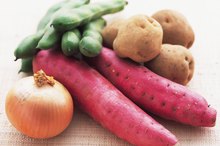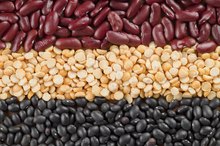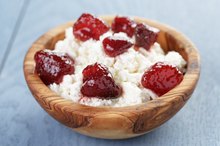Essential Amino Acids in Peanut Butter
Touted as one of the best athletic foods available by sports nutritionist and Registered Dietitian Nancy Clark, peanut butter offers modest amounts of protein as well as energy in the form of heart-healthy fats. It also provides your diet with magnesium, zinc, folate and vitamin E. The protein in peanut butter – approximately 7 g per 2 tbsp. – is not complete, however. In other words, it does not contain all the essential amino acids you need for optimal health.
Function
Amino acids serve as the building blocks of protein in your diet. When you consume a protein-containing food, your digestive system breaks down the protein into its constituent amino acids. Your body then creates new proteins as needed from the pool of dietary amino acids. Of the 20 amino acids in the foods you eat, nine are essential to your diet because your body cannot synthesize them. If your diet lacks one or more of these, your body degrades your muscle tissue to obtain the missing amino acids. Peanut butter protein is a so-called incomplete protein, as it does not offer all the essential amino acids.
- Amino acids serve as the building blocks of protein in your diet.
- Of the 20 amino acids in the foods you eat, nine are essential to your diet because your body cannot synthesize them.
Amounts
Essential Amino Acids in Vegetables
Learn More
The nine essential amino acids are histidine, isoleucine, lysine, methionine, phenylalanine, threonine, tryptophan and valine. Peanut butter is rich in leucine and phenylalanine, containing roughly 0.5 g and 0.4 g per 2 tbsp., respectively, according to the U.S. Department of Agriculture National Nutrient Database 4. Tyrosine, valine, lysine, isoleucine and threonine are present in moderate amounts, with 2 tbsp. of peanut butter providing between 160 and 260 mg of each. Histidine is the second-lowest essential amino acid in peanut butter, at 100 mg per 2 tbsp., while tryptophan is peanut butter’s limiting amino acid, present at less than 75 mg in 2 tbsp.
- The nine essential amino acids are histidine, isoleucine, lysine, methionine, phenylalanine, threonine, tryptophan and valine.
- while tryptophan is peanut butter’s limiting amino acid, present at less than 75 mg in 2 tbsp.
Food Combination
Although peanut butter does not contain enough of all the amino acids to qualify as a high-quality protein, you can combine it with other foods to create a nutritionally complete protein. For example, eating your peanut butter on whole wheat toast or combining it into smoothie with yogurt or powdered milk supplies your diet with the full complement of amino acids you need for optimal health. In fact, any legume in combination with a grain or a small amount of animal protein supplies your diet with essential amino acids.
Other Considerations
Foods High in Chromium, Carbon, Phosphorus & Tryptophan
Learn More
Understanding the amino acid profile of peanut butter may help you design a healthy diet to meet your fitness needs. As a concentrated source of energy, peanut butter provides you with calories to fuel your activities and with some of the amino acids you need to build muscle and support your bodily functions. In addition, the protein and fat content of peanut butter helps you feel full for a longer period of time than foods with simple carbs.
Related Articles
References
- BeginnerTriathlete.com; Peanut Butter: A Super Sports Food; Nancy Clark; November 2004
- Oklahoma Cooperative Extension Service; Protein and the Body; Janice Hermann
- The Biology Project; The Chemistry of Amino Acids; September 2003
- U.S. Department of Agriculture; National Nutrient Database for Standard Reference: Search; 2010
Writer Bio
A writer since 1985, Jan Annigan is published in "Plant Physiology," "Proceedings of the National Academy of Sciences," "Journal of Biological Chemistry" and on various websites. She holds a sports medicine and human performance certificate from the University of Washington, as well as a Bachelor of Science in animal sciences from Purdue University.









